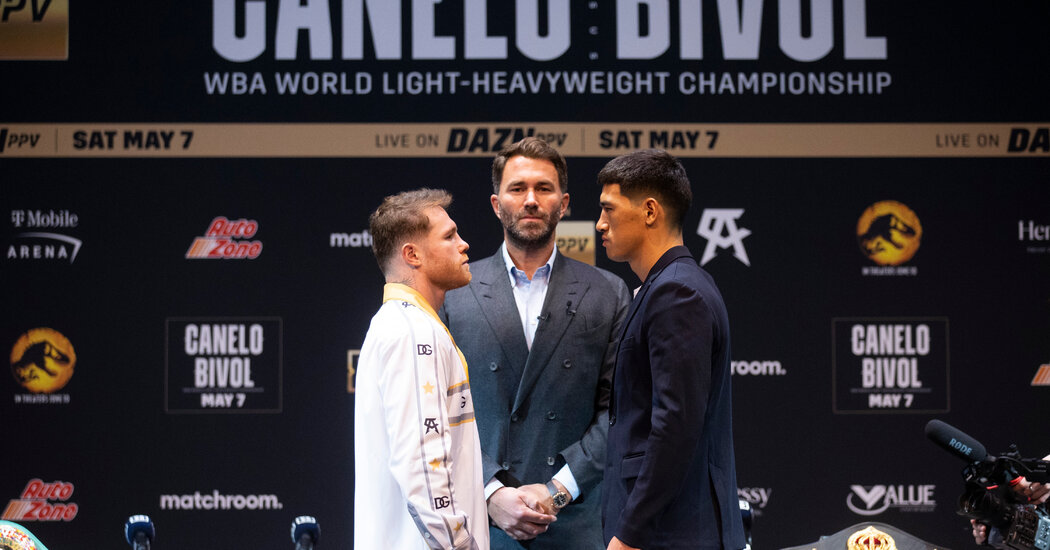
LAS VEGAS — At their final news conference on Thursday, Saul Álvarez, known as Canelo, glared up at Dmitry Bivol, who was posed for a routine prefight photo.
For Saturday’s bout at the T-Mobile Arena, Álvarez, the undisputed world champion at 168 pounds, will jump to the 175-pound weight class to challenge Bivol. The matchup has excited avid boxing fans curious to see if the 5-foot-8 Álvarez’s skill and strength will translate to a higher weight class against the 6-foot Bivol. And it has a built-in audience with Álvarez, a native of Guadalajara, Mexico, headlining a fight card on the weekend after Cinco de Mayo.
The event will stream to DAZN, the service that recently signed Álvarez to a two-fight deal. Only, DAZN subscribers will have to pay an additional $60 for Saturday’s card. Nonsubscribers will be charged $80 for the fight, which comes with a one-month subscription.
DAZN is selling Saturday’s fight card as a pay-per-view, in a major strategic shift for a company that positioned itself as a sports-centric version of Netflix, where subscribers pay a monthly fee to access the company’s entire content library. When DAZN began its boxing operation in 2018, its then-CEO, James Rushton, called the pay-per-view model overpriced and inefficient.
The pivot to pay-per-view suggests to DAZN’s critics and competitors that the financial reality of high-level boxing has hit the streaming service like an Álvarez uppercut.
“Calling for the end of pay-per-view is a nice marketing angle, but the reality is very different,” said Stephen Espinoza, president of Showtime Sports. “They didn’t have the volume to have a consistent subscriber base.”
But Joe Markowski, DAZN’s executive vice president, called the move to pay-per-view a natural response to an evolving market.
“It’s not a case of we miscalculated,” Markowski said. “This is about DAZN stepping into a new phase of its growth in the U.S. If we want to continue delivering fights like this to fight fans, we need to take some decisions like this occasionally.”
At its launch, DAZN entered the boxing market with two big transactions. First, it signed an eight-year, $1 billion contract with Matchroom Sports, to provide a steady supply of quality fights that would justify consumers’ decision to subscribe. Then it announced a $365 million deal with Golden Boy, Álvarez’s then-promoter, that would deliver 11 of his bouts to the streaming service, securing the presence of boxing’s biggest individual attraction on DAZN’s platform.
DAZN had hoped the deal would culminate in a third bout between Álvarez and Gennady Golovkin, who had also partnered with the streaming service. The first two Álvarez-Golovkin bouts totaled 2.4 million pay-per-view buys, a huge number in a sport where 300,000 is considered a success.
But since those blockbuster contracts, Álvarez’s relationship with Golden Boy fizzled in a series of lawsuits. As a promotional free-agent, Álvarez fought a series of bouts under Matchroom and DAZN, one of which attracted 73,126 spectators to AT&T Stadium in Arlington, Texas.
Last November, Álvarez jumped to Showtime and knocked out Caleb Plant to win the undisputed super-middleweight title and collect a reported $40 million payout. Those big guarantees made Álvarez’s return to pay-per-view inevitable, regardless of the platform, said Matchroom chairman Eddie Hearn.
“It is impossible to do Canelo Álvarez fights as part of a tiny subscription cost without hemorrhaging millions and millions of dollars,” Hearn said. “Times evolve. Things change. The market’s changed. If you want to do a Canelo fight, this is how you have to do it.”
There’s no team-sports analogue for boxing’s pay-per-view model. The N.F.L. does not put the Super Bowl behind a paywall, nor does Netflix charge extra for the new season of “Ozark.” But subscriptions, sponsors and rights fees do not generate enough revenue to support the eight-figure guarantees Álvarez commands.
Espinoza suggests thinking of pay-per-view as a crowdfunding program, financed by fight fans.
Álvarez, 31, drew a reported 800,000 pay-per-view buys for the November bout in which he dismantled Plant, he expects a more complicated challenge this Saturday. In his first fight at light heavyweight, a knockout win over Sergey Kovalev in November 2019, Álvarez, who stands 5-foot-8, needed several rounds to adjust to 6-foot-tall Kovalev’s size. Bivol shares Kovalev’s height, but is a better tactical boxer, with a long, well-timed jab that could disrupt Álvarez.
“He’s a light heavyweight, and one of the best in the division. A great fighter,” Álvarez said in a Zoom interview. “It opens the possibility of me maybe being the undisputed champion at 175, too.”
Bivol, who is undefeated in 19 pro fights, also enters Saturday’s bout with bulletproof confidence.
“I believe in me,” Bivol said at a news conference. “I had a long trip to this moment, and now I have to do my job.”
Boxing aficionados might find the matchup of styles intriguing, but selling the bout to a wider audience still depends on Álvarez’s star power. His $15 million guarantee is a fraction of his upfront pay for the Plant bout, but also hints that Álvarez expects a windfall when he receives his cut of pay-per-view revenue.
After Katie Taylor and Amanda Serrano drew 1.5 million viewers for their main event on DAZN a week ago, Markowski expects robust sales for Álvarez and Bivol.
“We’ve got targets to hit,” Markowski said. “We’ll be tracking Saturday and the days to follow.”
The evolving market has changed the definition of pay-per-view success. In 2015, Floyd Mayweather and Manny Pacquiao’s long-awaited showdown drew 4.6 million buys; before that, each fighter routinely drew more than 1 million pay-per-view buys. But Mayweather and Pacquiao were generational stars with mainstream fame. For most other headliners, Espinoza said, 100,000 buys is respectable, and 300,000 is impressive.
Espinoza and Markowski both say pay-per-view is best used as an occasional supplement to programming, lest broadcasters fatigue or insult customers by charging a premium for lackluster events.
“As long as, when we charge filet mignon prices, we’re delivering filet mignon content, then I think it’s OK,” Espinoza said. “The problem is when you’re charging filet mignon prices and delivering ground beef.”

